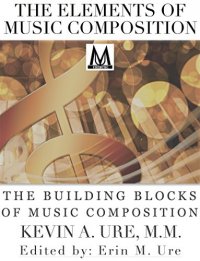Are you wondering what you’re missing in your music compositions? Do you want to create new sounds that go beyond well-established chords and progressions? This book teaches you the concepts of music composition without all of the arbitrary exercises found in so many theory books. Order this book and compose your story today.
Designed for the Composer Without Formal Training
Pulling back the veil to reveal how master composers create original works
Directed towards musicians who have some understanding of music theory and composing but lack formal training in music composition, this book deconstructs the dogma associated with the seemingly impenetrable art of music composition. Composers are taught the concept of organic music and begin to develop an understanding of how coherence and comprehensibility play a major role in the creation of musical works.
Understand the Principles Composers Use to Create Masterworks
Music theory is only a stepping stone to the creation of original music compositions
Music theory fails to account for an individual’s capacity to experience beauty and emotion in a musical work, and it only teaches a composer to replicate an established style. While music theory won’t teach you to think about composing like one of the masters, it’s still important for composers to study music theory to gain exposure to the techniques developed by the master composers of the past. Music theory is an excellent training tool, but the composer who wants to go beyond the ordinary must dissect the composing process and reveal its mysteries.
Go Beyond Music Theory to Create Effective Musical Works
Teaching the principles of construction gives composers the ability to create original works
While student composers need to learn established systems of music theory and composition, systems should be abandoned when it comes time to compose authentic works of art. This text details the elements of a musical work and describes how a composer uses melody, harmony, form, orchestration, and timbre using a connected process where every element contributes to the composition and serves a role.
A Practical Approach to Music Composition Without Arbitrary Exercises
The craft of music composition is revealed through a careful review of the elements of music
Composers will not complete exercises, improve technique, or learn the typical concepts addressed in your average music composition course. This text aims to get deep inside the process of composing to reveal fundamental principles that apply to several musical styles.
Generic exercises that instruct a composer to create a melody on an established chord progression, fix voice leading errors, and create modulations to scripted keys do not promote original thought. Composers must be taught the principles behind the theories to understand how to compose original music that stems from a deep understanding of the nature of music.
Suitable for the Casual Listener or the Professional Composer and Musician
Learn to compose music not through the study of other composers theories, but through universal principles that apply to musical works.
The best composers in history learned to write music by following in the footsteps of those who came before. Composers created music based on principles of voice leading and counterpoint before the advent of music theory. Beethoven was notorious for carefully working out counterpoint exercises, and he went to great lengths to ensure his exercises followed the proper procedures. Mozart used counterpoint to teach his own students.
This book teaches you the basic underlying principles of music composition so you can create effective musical works based on sound principles of music composition.












